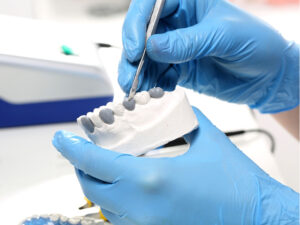Painless and comfortable tooth removal
To alleviate pain and prevent further damage.
What is Tooth Extraction
Tooth extraction, also known as dental extraction or exodontia, is a dental procedure involving the removal of a tooth from its socket in the jawbone. This procedure is typically performed when a tooth is damaged, decayed, infected, or causing other oral health issues.
Causes for Tooth Extraction:
- Severe decay: When decay extends deep into the tooth and compromises its structural integrity, extraction may be necessary.
- Gum disease: Advanced periodontal disease can lead to loose teeth that require extraction to prevent further spread of infection.
- Impacted wisdom teeth: Wisdom teeth that are unable to erupt properly or become impacted against neighboring teeth may need to be extracted.
- Orthodontic treatment: In some cases, tooth extraction is performed as part of orthodontic treatment to create space for proper tooth alignment.
- Trauma: Teeth that are severely damaged due to trauma from accidents or injuries may need to be extracted if they cannot be saved through other means.
Consultation:
During the consultation for tooth extraction, the dentist will:
- Evaluate the condition of the tooth and surrounding tissues through a thorough examination and possibly X-rays.
- Discuss the reasons for extraction and alternative treatment options, if available.
- Develop a treatment plan tailored to the patient’s specific needs and concerns.
- Address any questions or concerns the patient may have about the procedure and aftercare.
Available Treatments:
Tooth extraction can be performed using various techniques, depending on the tooth’s position, condition, and the patient’s overall oral health:
- Simple extraction: This procedure is used for visible teeth that can be easily accessed by the dentist. The tooth is loosened with a dental instrument called an elevator and then removed using forceps.
- Surgical extraction: For teeth that are impacted, severely damaged, or difficult to access, surgical extraction may be necessary. This procedure involves making an incision in the gum tissue and possibly removing bone to access the tooth.
Aftercare:
After tooth extraction, it’s essential to follow your dentist’s instructions for aftercare, which may include:
- Applying ice packs to reduce swelling and discomfort.
- Taking prescribed medications, such as pain relievers or antibiotics, as directed.
- Avoiding vigorous rinsing, spitting, or drinking through a straw, which can dislodge the blood clot and delay healing (known as dry socket).
- Eating soft foods and avoiding hard, sticky, or crunchy foods that could irritate the extraction site.
Advantages of Root Canal Treatment:
- Pain relief: Extracting a severely decayed or infected tooth can provide immediate relief from pain and discomfort.
- Prevention of further damage: Removing a damaged or decayed tooth can prevent the spread of infection to neighboring teeth and surrounding tissues.
- Preparation for orthodontic treatment: Tooth extraction may be necessary to create space for proper tooth alignment during orthodontic treatment.
Disadvantages of Root Canal Treatment:
- Loss of function: Extracting a tooth can affect chewing and speaking, especially if it’s a visible or essential tooth.
- Changes in facial appearance: Tooth extraction can lead to changes in facial structure and smile aesthetics, particularly if multiple teeth are removed.
Photos:
Tooth Extraction FAQ
With the use of local anesthesia and sedation techniques, tooth extraction is typically not painful during the procedure. Some discomfort and swelling may occur afterward but can be managed with pain medications and ice packs.
Recovery time varies depending on the complexity of the extraction and the patient’s overall health. In general, it takes about one to two weeks for the extraction site to heal fully.
Yes, missing teeth can be replaced with dental implants, bridges, or dentures to restore function and aesthetics.
Conclusion:
Tooth extraction is a common dental procedure performed to address various oral health issues, including severe decay, gum disease, impacted wisdom teeth, and trauma. While extraction may be necessary in some cases to alleviate pain and prevent further damage, it’s essential to discuss treatment options with your dentist to make informed decisions about your oral health and well-being. Following proper aftercare instructions can help promote healing and prevent complications following tooth extraction.
Services
Specialists







